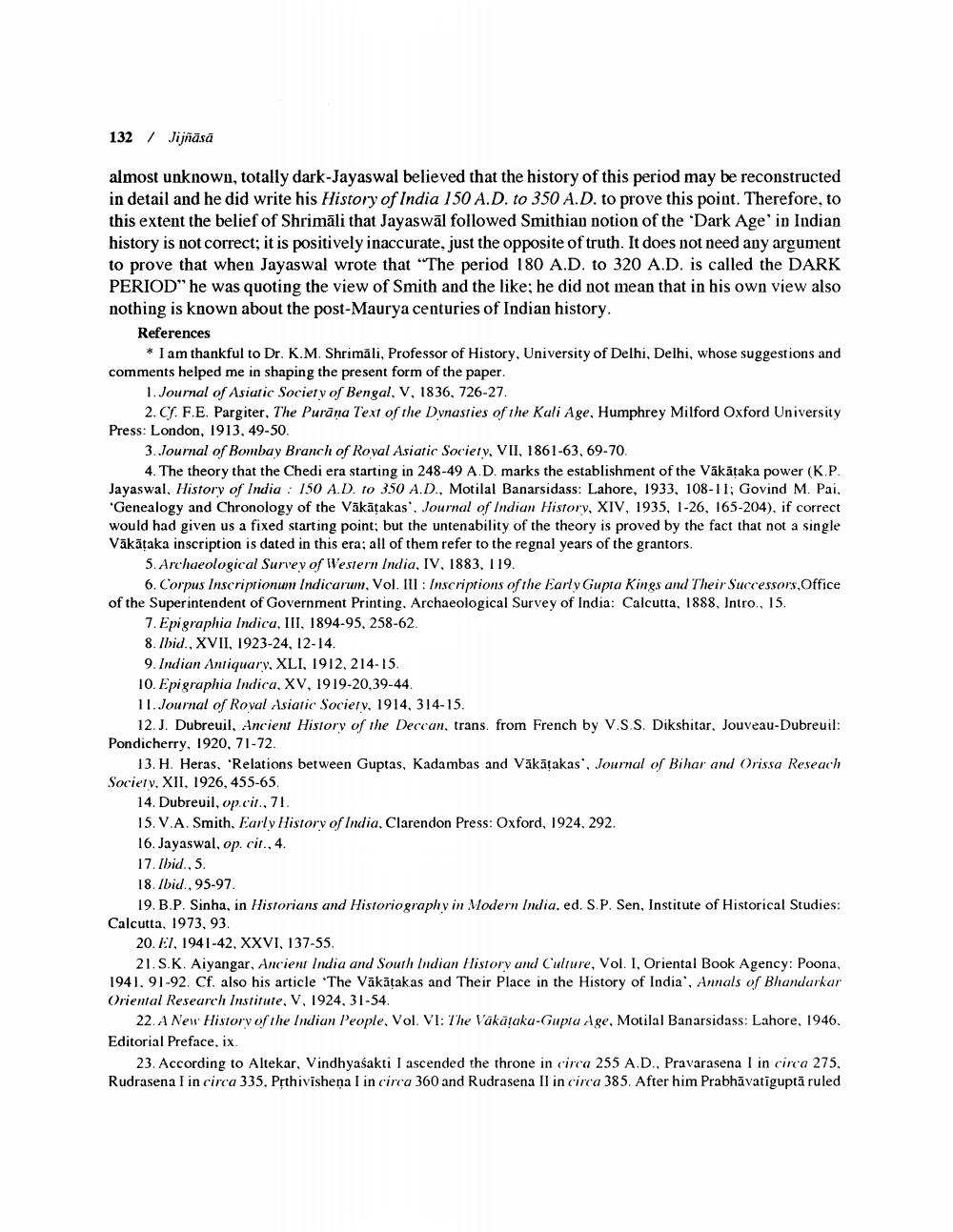________________
132
/
Jijñāsa
almost unknown, totally dark-Jayaswal believed that the history of this period may be reconstructed in detail and he did write his History of India 150 A.D. to 350 A.D. to prove this point. Therefore, to this extent the belief of Shrimāli that Jayaswāl followed Smithian notion of the 'Dark Age' in Indian history is not correct; it is positively inaccurate, just the opposite of truth. It does not need any argument to prove that when Jayaswal wrote that "The period 180 A.D. to 320 A.D. is called the DARK PERIOD"he was quoting the view of Smith and the like; he did not mean that in his own view also nothing is known about the post-Maurya centuries of Indian history.
References
* I am thankful to Dr. K.M. Shrimāli, Professor of History, University of Delhi, Delhi, whose suggestions and comments helped me in shaping the present form of the paper.
1. Journal of Asiatic Society of Bengal, V, 1836, 726-27.
2. Cf. F.E. Pargiter, The Purāna Text of the Dynasties of the Kali Age, Humphrey Milford Oxford University Press: London, 1913, 49-50.
3. Journal of Bombay Branch of Royal Asiatic Society, VII, 1861-63, 69-70.
4. The theory that the Chedi era starting in 248-49 A.D. marks the establishment of the Vākātaka power (K.P. Jayaswal, History of India : 150 A.D. to 350 A.D., Motilal Banarsidass: Lahore, 1933, 108-11; Govind M. Pai, 'Genealogy and Chronology of the Vākātakas', Journal of Indian History, XIV, 1935, 1-26, 165-204), if correct would had given us a fixed starting point; but the untenability of the theory is proved by the fact that not a single Vākāțaka inscription is dated in this era; all of them refer to the regnal years of the grantors.
5. Archaeological Survey of Western India, IV, 1883, 119.
6. Corpus Inscriptionum Indicarum, Vol. III : Inscriptions of the Early Gupta Kines and Their Successors, Office of the Superintendent of Government Printing. Archaeological Survey of India: Calcutta, 1888. Intro., 15.
7. Epigraphia Indica, III. 1894-95, 258-62 8. Ibid., XVII, 1923-24, 12-14. 9. Indian Antiquary, XLI, 1912, 214-15. 10. Epigraphia Indica, XV, 1919-20,39-44 11. Journal of Roval Asiatic Society, 1914, 314-15.
12. J. Dubreuil, Ancient History of the Deccan, trans, from French by V.S.S. Dikshitar, Jouveau-Dubreuil: Pondicherry, 1920, 71-72.
13. H. Heras, Relations between Guptas, Kadambas and Vākātakas", Journal of Bihar and Orissa Reseach Society. XII, 1926, 455-65.
14. Dubreuil, op.cit., 71. 15. V.A. Smith, Early History of India. Clarendon Press: Oxford, 1924, 292. 16. Jayaswal, op. cit., 4. 17. Ibid., 5. 18. Ibid., 95-97.
19. B.P. Sinha, in Historians and Historiography in Modern India, ed. S.P. Sen, Institute of Historical Studies: Calcutta, 1973, 93.
20. EI, 1941-42. XXVI, 137-55.
21. S.K. Aiyangar, Ancient India and South Indian History and Culture, Vol. I, Oriental Book Agency: Poona, 1941, 91-92. Cf. also his article 'The Vākāțakas and Their Place in the History of India', Annals of Bhandarkar Oriental Research Institute, V, 1924, 31-54.
22. A New Historv of the Indian People, Vol. VI: The Vakātaku-Guplu Age, Motilal Banarsidass: Lahore, 1946. Editorial Preface, ix
23. According to Altekar, Vindhyasakti 1 ascended the throne in circa 255 A.D., Pravarasena I in circa 275, Rudrasena I in circa 335. Prthivishena I in circa 360 and Rudrasena Il in circa 385. After him Prabhāvatīguptā ruled




